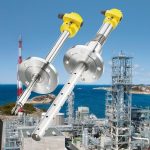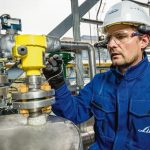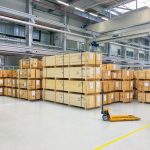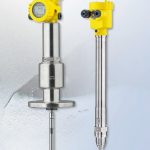LNG processes are among the most challenging in the process industry. A single plant can produce anything from 40,000 to 8 million tons annually. Processing facilities can range from very small to world-scale. Two trends are becoming apparent in liquefaction plants.
First, the future can swim. LNG plants are increasingly being designed as “floating facilities” (FLNG). Gigantic floating liquefaction plants, sometimes as big as several football pitches, can produce LNG exactly where natural gas is available, without first having to transport it ashore through expensive pipelines. The industry is thus achieving an unprecedented level of flexibility and service quality true to the motto “We come to you and deliver to your door”.
Second, large-scale natural gas liquefaction plants need staying power and the willingness to make large investments. Current projects are therefore tending to move away from the huge dimensions the growth market demanded in the past. Medium-sized projects are becoming more and more the thing. These allow both the project duration and the financial investment to be scaled and closely matched to demand, so that production can still be profitable in regions with smaller gas reserves. What’s more, such facilities can be expanded later with comparatively little effort to meet increased demand. After all, extending an existing facility is faster and easier than starting from scratch somewhere else. An additional compressor train, turbine or cold box, i.e. the cryogenic chamber where natural gas is cooled down to -162 °C, requires relatively little bureaucratic red tape.
All-round reliability with a complete measuring point
The Linde Group delivers comprehensive turnkey solutions for the LNG processes at its customers’ plants. Just as comprehensive are the level measurement solutions Vega creates for these same processes. A complete measuring system consisting of a bypass tube and sensor offers much more than just the sum of its parts. It includes an instrumentation concept tailored to the process and rounded off with broad engineering and support services. The ready-to-install sensors, which are shipped with customised features, documentation and necessary test certificates – all from a single source – are a building block Linde can rely on. Using Vegaflex 86 guided radar sensors, most of which come already fitted in bypass tubes, and Vegaswing 66 for point level detection enables considerable savings, amongst other things due to the simplified planning, fast plug & play installation and reduced maintenance requirements. Since they have no mechanical moving parts, Vegaflex bypass measuring systems are wear-free and need almost no servicing. Besides pre-assembly and adaptation to existing plant conditions, the scope of delivery also includes detailed parameterisation, such as false signal suppression. Only SIL functionalities, as required by law, have to be calibrated live on site with the original medium that will later be measured.
Documentation included
When designing LNG facilities, the top priority is to make sure all system components have sufficient robustness and performance reserves. Only then are the sensors able to reliably monitor the complex processes the media are put through. The core task hasn’t changed much in spite of all the technical advances over the last few decades. Yet in terms of efficiency and process reliability, today’s measuring systems are almost unrecognisable. On their journey to the LNG construction site, the client’s level sensors are accompanied by a thick bundle of papers. The aim is to comply with strict legal regulations and the often stricter still, country-specific requirements of end customers. Apart from production acceptance tests, the focus is on numerous certificates and licenses.
The challenge of short-track projects
The Portovaya project is a so-called short-track project. “The entire plant is being built in an unusually short period”, explains Business Development Manager Sebastian Harbig, who is in charge of global projects at Vega. “Delivery time was therefore a major criterion when awarding the contract.” This is not the first time that Vega has supported the engineering, procurement & construction (EPC) specialist on medium- or large-scale projects. Vega is responsible for the complete, ready-to-install measuring point, the customer-specific documentation and all necessary certificates. Especially for international projects, delivery from a single source is an advantage that has multiplication potential because a project like the one in Portovaya involves Linde teams, locations and suppliers all over the world. The work across national borders has to function like a well-oiled machine, with every gear wheel syncing perfectly with all the others. Any delay can cause multiple delays downstream.
Two for all levels
Machines in an LNG plant, particularly those used in the liquefaction process, are exposed to extreme operating conditions. Between start-up and full operation of the cryogenic processes, the temperature expansion of the equipment is immense. The components are subject to extreme loads and even small changes in the composition of the processed natural gas can significantly reduce the overall service life of a machine. The mid-scale plant now being built in the Russian Baltic bay liquefies gas from a compressor station that has been operating there since 2010. The process for converting natural gas into LNG is based on three steps: pre-treatment, compression and cooling including liquefaction. Since natural gas contains impurities such as water, mercury or corrosive components that can freeze during the compression phase, it has to be pre-treated. Methane is only allowed to enter the liquefaction trains of the LNG plant in a highly concentrated form. In the various storage and process vessels, only two sensor types monitor the very diverse media – from dry natural gas, condensed hydrocarbons and cold flare gas to ethane, LNG, hydrocarbons, fuel gas and wastewater – during the entire production process.
Maximum performance, minimal loss
Consistently high quality is essential for LNG processes. In today’s competitive environment, industry must strike a balance between cost pressure and environmental awareness. Yet when it comes to quality, no compromises are tolerated. Efficiency and plant availability, which are significantly improved through standardisation in all areas including instrumentation, guarantee high quality and a real cost advantage. Guided radar sensors are especially suitable here because they can reliably withstand extreme pressure and temperature conditions. Vibrating level switches, with their compact design and millimetre accuracy, are also ideal for many applications in an LNG plant.
Communication that counts
Vega’s global projects team, to which Sebastian Harbig belongs, has developed into an experienced partner for worldwide plant projects with extensive knowledge of critical interfaces. To be able to supply customers optimally, it is important to provide comprehensive solutions that are far removed from daily business. Mature technology, as the project in Portovaya shows, can merely be the basis on which to build. In practice, there is far more to it than that: working out the technical details, preparing quotations and communicating regularly with the client. The project does not end with setting up and commissioning but continues throughout the entire lifecycle
of the instruments, ensuring the best possible availability and efficiency.
Online search: cpp0219vega
Sensors: In the LNG/LPG process chain
Liquefaction plants are relatively complex and extend over multiple process stages. In each stage, the level is an important variable playing a major role in protecting the compressor. Vegaflex 86 is a hard-wearing guided radar sensor which is ideal for this task, because it measures without being affected by media properties such as density or dielectric constant. Its rugged mechanical design and second seal, the so-called second line of defence, protect the sensor effectively.
The Vegaswing 66 vibrating level switch has a patented inductive drive that excites the tuning fork effortlessly even under extreme temperature conditions. Users benefit especially from the simple handling and operation of this device. Notwithstanding its simplicity, it has an extensive application range down to -196 °C (normal temperature in the LNG environment) and is rated for pressures from -1 to +160 bar. Since the sensor measures so reliably irrespective of density, even in widely different products, it is perfect for high and high-high alarms on cargo tanks.











